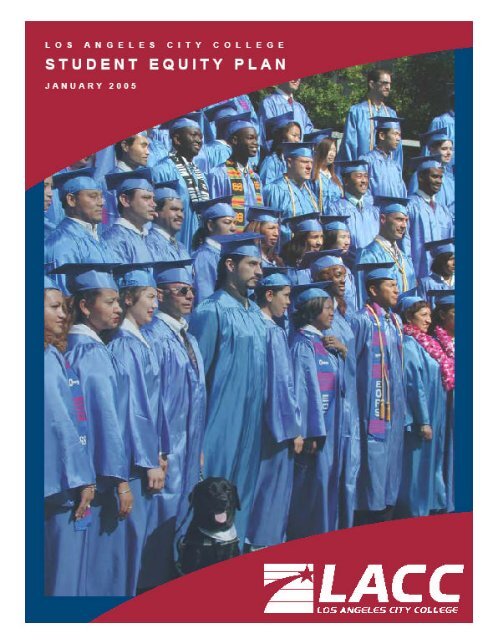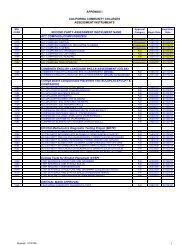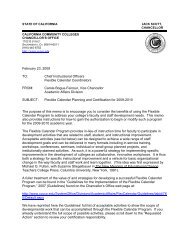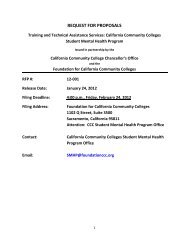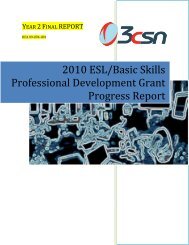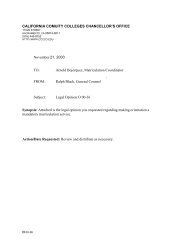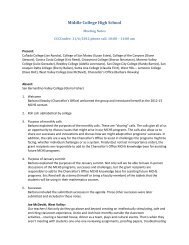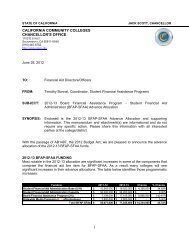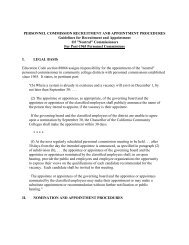Los Angeles City College
Los Angeles City College
Los Angeles City College
You also want an ePaper? Increase the reach of your titles
YUMPU automatically turns print PDFs into web optimized ePapers that Google loves.
<strong>Los</strong> <strong>Angeles</strong> Community <strong>College</strong> District <strong>Los</strong> <strong>Angeles</strong> <strong>City</strong> <strong>College</strong><br />
Executive Summary<br />
2
Executive Summary<br />
California’s Master Plan for Higher Education, created in 1960, guarantees that all Californians,<br />
with a high school degree or equivalent, could access higher education by enrolling in<br />
the state’s community colleges. Community colleges have become the gate-keepers for the<br />
four-year colleges and universities, expected to produce qualified transfer-ready students as<br />
well as address the expanding need for basic skills and ESL education.<br />
The majority of the population served at <strong>Los</strong> <strong>Angeles</strong> <strong>City</strong> <strong>College</strong> faces financial, language<br />
and preparatory barriers. LACC represents a second chance for many students who arrive<br />
here ill-prepared to succeed in a traditional academic environment. The college is committed<br />
to providing the academic programs that students seek and the support services to assist them<br />
in achieving their educational goals. This plan seeks to identify the gaps in success rates<br />
among the populations served and address them.<br />
California Tomorrow, a non-profit research and advocacy organization, published California’s<br />
Gold: Claiming the Promise of Diversity in our Community <strong>College</strong>s in 2003. It cites the challenges<br />
facing our community colleges:<br />
• “a public policy climate in which the mission and survival of community colleges is threatened<br />
by insufficient attention, inadequate investment and lack of understanding of the role<br />
community colleges play in the lives of diverse communities and the state;<br />
• little accountability within the system for access, equity and diversity;<br />
• insufficient counseling and student supports, resulting in barriers to successful completion<br />
of education and aspirations;<br />
• few faculty and staff of color; insufficient training to help faculty and staff work effectively<br />
with a diverse student body;<br />
• heavy reliance on part-time faculty members who are not able to provide much extra time<br />
and support to immigrant students, students of color and first generation college-goers;<br />
• insufficient access to financial aid for a student population that often shoulders substantial<br />
family and work responsibilities;<br />
language barriers and a lack of understanding of immigrant students’ needs.”<br />
While identifying gaps and creating activities to minimize them, the Student Equity Plan cannot<br />
address all of the factors that contribute to student success. However, it is hoped that by calling<br />
attention to varying success rates, etc., we can help focus the college community’s attention<br />
on utilizing the many strengths of LACC to achieve improved outcomes for all of our students.<br />
This Student Equity Plan follows the procedures required by the State Chancellor’s Office. The<br />
populations are identified by ethnicity, gender and disability. It should be noted that another<br />
population worth identifying is immigrant status. These students often have special needs that<br />
must be addressed beyond looking at ESL success rates. The traditional assumption is that<br />
immigrant populations are within the Hispanic and Asian/Pacific Island groups. LACC serves a<br />
large Eastern European immigrant community that is included within the White ethnic designation.<br />
For the first indicator, two target groups were identified for achieving equity in access to the<br />
college. The Hispanic population in the community is 46% while enrollment of Hispanic students<br />
was at 41% of the college’s total student population (Fall 2003), down from a high of<br />
3
45% in 1999. The male enrollment at the college is 43%. While less than the 50% of the adult<br />
population identified as male, it is actually 1% higher than the national average of male community<br />
college students in 1997 (Phillippe and Patton, 2000, as cited in California’s Gold).<br />
LACC’s male student population is higher in comparison with the other eight colleges within<br />
the <strong>Los</strong> <strong>Angeles</strong> Community District. While the gaps are not remarkable, the college has decided<br />
to establish goals and activities to increase the enrollment of both populations.<br />
There are two basic thrusts of the activities to increase enrollment for both Hispanic and male<br />
students. The Office of Institutional Effectiveness will research factors and influences that may<br />
be causing these groups not to enroll in community college and target marketing to these<br />
populations. They will also identify population trends within the community we serve. In addition,<br />
for the Hispanic group, the college will expand its bi-lingual activities to reach and serve<br />
Spanish speaking students for whom language is a barrier.<br />
A third group, the disabled students, also shows a gap in access. Members of the Student Equity<br />
Committee see that gap as one that exists within the college community. It is believed that<br />
many disabled students are enrolled at the college but are unaffiliated with the Office of Special<br />
Services (formerly DSPS). Therefore the activities to address this gap are directed to the<br />
current student population rather than out into the community.<br />
In the second area, the data on course completion rates indicates an appreciable gap in the<br />
success rates of both Hispanic and Black students, as compared to the White students. Several<br />
existing early intervention activities will be assessed for their effectiveness, and restructured<br />
and/or expanded as warranted. In an effort to institutionalize the on-going review of success<br />
among our diverse student populations, the Equity Plan calls for including ethnic data,<br />
and its analysis, in both academic and student services program review.<br />
The academic departments’ program reviews acknowledged the need to provide academic<br />
support for students’ success. The Equity Plan includes expansion of tutoring and access to<br />
instructional labs, such as the Math Pi Shop (see Attachment section) and the English Writing<br />
Lab. One very successful program, supplemental instruction, has demonstrated its positive<br />
effect on student outcomes, and one activity is to expand it. Data on the success of this activity<br />
is included in the Attachments section.<br />
The third aspect of student equity, ESL and Basic Skills completion, examines the success of<br />
students, by each group, who complete a degree applicable course after having completed the<br />
final ESL or basic skills course, within a two year time frame. As noted in California’s Gold,<br />
“students who took the basic skills/remedial coursework were slightly more likely to earn degrees<br />
and certificates, though it took them longer to do so. However, these students were less<br />
likely to transfer.” Further study is indicated on the goals of the students completing the ESL<br />
program to determine whether that was an end in itself, and, if that is the case, revising the<br />
method of evaluating this area.<br />
The data for the fourth student success indicator, degrees and certificate completion, indicated<br />
a gender based gap. A disproportionate number of female students are attaining degrees and<br />
certificates compared to the male population. The college needs to collect data on how the<br />
two populations compare in their educational goals and courses of study, and then analyze<br />
that data for its affect on awarding of degrees and certificates. With the data in hand, the college<br />
can detail activities to address any gaps that may exist. Prior data is included in the Attachments<br />
section; however, the Committee is requesting further delineation within the data.<br />
4
The last aspect to be addressed as a student success indicator is transfer. Using the college’s<br />
metric for this indicator, the Student Equity Committee found no disparity among the identified<br />
groups. Promoting transfer among all of LACC’s students is an on-going goal of the college. Additional<br />
data collected on transfer is included in the Attachments section.<br />
To support the activities of the Student Equity Plan, the college will be using Program 100 funds,<br />
as well as additional support from several categorical programs: Matriculation, BFAP (Financial<br />
Aid), and EOP & S, within their allowable expenditure, and the Title V grant, within its objectives.<br />
Contact person: Leanna Watts, Dean, Student Services (323) 953-4000, ext. 2450<br />
855 North Vermont Avenue <strong>Los</strong> <strong>Angeles</strong> CA 90029<br />
Email: wattslf@lacitycollege.edu<br />
5


